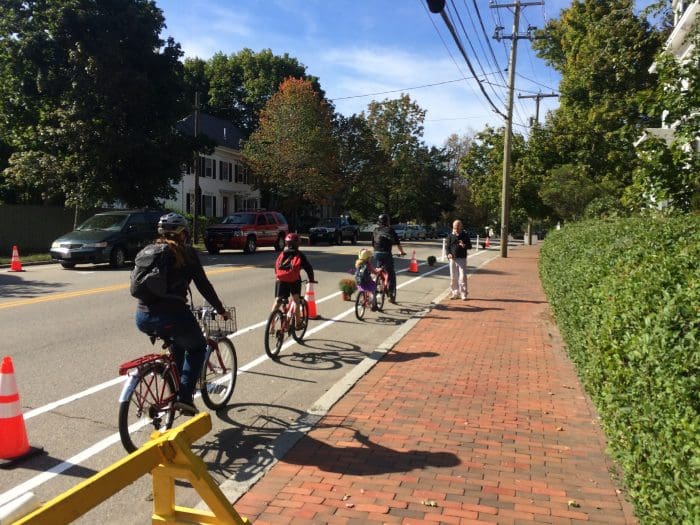October 6, 2015
City officials in Portsmouth, New Hampshire, arrived at Middle Street early in the morning armed with plastic posts, hay bales, and flower pots. Staff from the Planning and Public Works Departments began remaking the street, which serves as a gateway to the city’s historic downtown. Using these materials and some heavy-duty reflective white tape, they created several short stretches of separated bike lanes in only a couple hours.
Juliet Walker, AICP, Transportation Planner with the City of Portsmouth, says, “Separated bike lanes are a new concept in Portsmouth, so we wanted to give the community a chance to see how they might work. It helps us actually show people what the possibilities are in the context of the actual setting rather than using photos from other places.”
The pilot demonstration drew neighbors out of their houses and attracted cyclists from across the city to try out the new bike lanes. Families with very young children showed up, grateful to see the city looking for ways to make bicycling safer and more comfortable.
“The intent of this event is to allow people to see how the proposed lanes will look and feel on location, and we are also hoping they take the opportunity to try them out for themselves,” said Walker, “We hope it will be helpful for people in addition to being a fun event.”

Kittelson & Associates, Inc. (Kittelson) helped design the pilot, along with local engineers from Greenman-Pedersen, Inc. “A pilot like this is a great way to engage the community. It helps people visualize how their streets might work differently, and it allows people to participate right in their neighborhood,” observed Conor Semler, a Senior Planner with Kittelson. “It’s a lot easier than convincing people to come to the middle school auditorium on a Saturday.”
Communities across the country, from small-town Kansas to the middle of Atlanta, have been hosting similar events to give thousands of Americans their first taste of a protected bike lane. Last year the city of Minneapolis spent an estimated $600 and constructed 15 plywood planters to demonstrate how projected bike lanes would work in their city. Watch a video about the event.
Most of the materials used in the Portsmouth pilot were donated or re-purposed from other projects. Traffic Safety Store lent the city the posts and bike symbol markings which helped create the look of an official, if temporary, bike facility. The city collected feedback from people during the pilot and held a follow-up meeting to advance the project into the final design phase.
People voiced widespread support for the separated bike lane design, which should be completed next spring.

